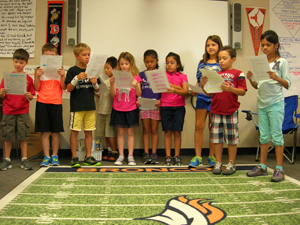 Teachers who want to make Readers Theatre a more regular part of their reading curriculum often ask us where to find scripts for their students to perform. Although school and community libraries, as well as most classrooms, are filled with stories, informational texts, and reading materials, individual and collections of scripts are not as easy to find—especially if a teacher has a particular topic or concept in mind. In this post, we hope to help teachers become more adept at finding the kinds of scripts they want to bring into their classrooms.
Teachers who want to make Readers Theatre a more regular part of their reading curriculum often ask us where to find scripts for their students to perform. Although school and community libraries, as well as most classrooms, are filled with stories, informational texts, and reading materials, individual and collections of scripts are not as easy to find—especially if a teacher has a particular topic or concept in mind. In this post, we hope to help teachers become more adept at finding the kinds of scripts they want to bring into their classrooms.
The following are five suggestions for finding scripts or creating your own.
- Search published collections. The first place to look for scripts is where you already look for books and other reading materials: in your classroom, school, and community libraries. Although limited in numbers and scope, most children’s librarians will stock their shelves with at least a few scripts that can be practiced and performed in a classroom setting.
- Check the Internet. The Internet has a vast repository of scripts that can be easily downloaded and copied for classroom use. Many of the scripts you will find online are actually written by teachers who upload them for public use. A Google search yields a host of free sites (such as timrasinski.com and thebestclass.org) that offer a variety of scripts for free download.
- Write your own scripts. This might be a great time to tap into your writing potential, shake off your writer’s block, or enhance your amateur writing career. You can transform almost any text into a script. After choosing a text, consider how to approach the scripting process. Some texts have plenty of dialogue while others are heavily narrated, in which case you can add several narrator parts or change narration into dialogue. For instance, if the text reads, “Superman flew faster than ever to save Lois,” you could modify it so that Superman’s dialogue tells the story, “Oh no! I have to fly faster than ever to save Lois!”
Creating your own scripts also enables you to cater to your students. For example, fifth-grade teachers might script a short section from a novel. If you have a class of emergent readers, a narrated or teacher-led script might be a more suitable starter script for your classroom. Or, you can make one up.
- Use poetry. We have also found that students love to perform poetry. You can choose any poem and easily transform it into a script by adding narrators. A great source for funny, child-friendly poems is gigglepoetry.com.
- Have students write the scripts. We feel that students themselves are the ultimate source for scripts. When students write scripts based on stories or segments of stories they have read, they must engage in deep comprehension and analysis. Making inferences is one of the highest forms of comprehension. When turning a story into a script, students learn how to create inferences through dialogue and description. Students can also create nonfiction or informational scripts. When doing so, they will have to perform research to ensure that the information they convey in the script is accurate.
We recommend that you start by scripting existing texts. Poetry is an easy genre to begin with; there’s very little dialogue, so students are essentially breaking the poems into meaningful phrases or stanzas and assigning narrators. In our experience, short stories are a good next step.
There are no limits on what texts can be used, so let your students choose their favorite texts and let their imaginations take over. We hope that this brief article provides you with enough resources to implement Readers Theatre throughout the year so you can see the results for yourself.
 Chase Young is an associate professor at Sam Houston State University and a former elementary school teacher. He is the coauthor with Timothy Rasinski of Tiered Fluency Instruction: Supporting Diverse Learners in Grades 2–5 (Capstone).
Chase Young is an associate professor at Sam Houston State University and a former elementary school teacher. He is the coauthor with Timothy Rasinski of Tiered Fluency Instruction: Supporting Diverse Learners in Grades 2–5 (Capstone).
 Timothy Rasinski is a professor of literacy education at Kent State University and a former elementary and middle school teacher. He is the author of the bestselling book The Fluent Reader (Scholastic) and a member of the Reading Hall of Fame.
Timothy Rasinski is a professor of literacy education at Kent State University and a former elementary and middle school teacher. He is the author of the bestselling book The Fluent Reader (Scholastic) and a member of the Reading Hall of Fame.
 Faida Stokes is a doctoral student in literacy at Sam Houston State University. Formerly a special education teacher, she is now an educational diagnostician. She is the coauthor with Chase Young and Timothy Rasinski of Readers Theater Plus Comprehension and Word Study to appear in The Reading Teacher.
Faida Stokes is a doctoral student in literacy at Sam Houston State University. Formerly a special education teacher, she is now an educational diagnostician. She is the coauthor with Chase Young and Timothy Rasinski of Readers Theater Plus Comprehension and Word Study to appear in The Reading Teacher.